Spring 1988 · Vol. 17 No. 1 · pp. 30–59
Mennonite Brethren in Three Countries: Comparative Profiles of an Ethno-Religious Tradition
In this paper we will report how Mennonite Brethren from three different types of “ethnic” backgrounds responded to the questions on the “Church Member Profile,” an extensive survey of the religious, familial, economic, and political attitudes and practices of members of the Mennonite churches. The “Profile” was initially developed by Howard Kauffman and Leland Harder in 1972, was revised and replicated by a group of Mennonite Brethren in 1982 (See Direction, Winter, 1985), and in 1985 was adapted and translated into Japanese as a cooperative project involving the leaders and members of five Mennonite related groups in Japan. We have reorganized the data from these surveys in order to identify some of the ways in which the responses of three types of members of the Mennonite Brethren churches are similar to and differ from one another: (a) Mennonite Brethren who received their childhood socialization in M.B. homes in Canada {31} and the U.S. (“ethnic” M.B.s who will be called “Family” M.B.s in this report); (b) U.S. and Canadian members who did not receive their childhood socialization in M.B. homes (“nonethnic” members who will be called “Choice” M.B.s in this report); and (c) members of the Mennonite Brethren churches in Japan (Japanese M.B.s). The fact that the survey was administered to Canadian and U.S. members in 1972 and again in 1982 enables us to note, also, some patterns of changes across this decade within the North American “ethnic” and “nonethnic” subgroups.
. . .a warm Christian faith which does not express itself in a radically disciplined community of Christian peace.
THEORY AND PREDICTIONS
We have assumed that faith and ethnicity have been closely interrelated in the history of Mennonites in North America, as they have been in the experience of other immigrant people. One of the theoretical issues which must be addressed, given this assumption, is whether it is possible for a sub-community to retain a distinctive cultural identity within the context of the “assimilating” power of Western cultures. The issues differ somewhat in Canada, Japan, and the United States, of course, but the basic question which is addressed by Robert Bellah and many others remains. What “traditional” forms retain enough vitality to provide an alternative to (1) the pervasive expressive and utilitarian individualism which characterizes “modern” society, or, on the other hand, (2) the despotism which seems to provide the antidote to the “anomie” that accompanies the disintegration of a social order? The Mennonite response to the latter peril (despotism) is told in our stories of migrations and martyrdom. But what is our response to the promise of personal and corporate acceptance and prosperity within the context of an open, democratic society which offers the freedom of a tolerant relativism in place of overt oppression?
The data have been organized around the assumption that “assimilation” is an appropriate model for an analysis of the recent experience of the Mennonite Brethren in North America. If this model is descriptive of our experience, we should expect to find that the membership of the Mennonite Brethren church is moving toward social, cultural, and religious conformity to the patterns of the surrounding society. We should find upward socio-economic mobility and a transition {32} from agrarian to urban life. We should find increasing pluralism within the group. We should find decreasing commitments to distinctive forms of thought (including theology) and behavior (involving increasing political engagement and decreasing ethical conservatism).
Conversely, we should expect to find increasing signs of acceptance of compatible aspects of the dominant social, cultural, and religious systems. We should find, for example, religion defined in more personal, private, and subjective terms, more concerned with self-affirmation than commitment to service within the context of peoplehood. We should find an increasing localism in religious orientation as congregations change from being sub-groups within a larger religious movement (a “community of memory”) to becoming “life style enclaves.” The “life style enclave” is a group which consists of members who are homogeneous in socio-economic background and who share only a limited range of common interests (defined as “religious” in the case of a church congregation). We should find members being attracted to a theological system which offers both social acceptance (at least within the circle of persons we adopt as points of reference in the world around us) and rational consistency, such as “fundamentalism,” or, more generally, “evangelicalism.” And we should find signs of acceptance of at least certain aspects of the “civil religion” which celebrates the legitimacy of the institutions of the state by encouraging acceptance of and participation in those institutions.
ETHNICITY AND DEMOGRAPHY
The indexes used in this study were reconstructed from the items used in the 1982 profile of North American M.B.’s. We have chosen to define “ethnicity” in this study operationally in terms of responses to a single item: “In your childhood and youth, were your parents members of the church denomination to which you now belong?” Since all respondents were members of the M.B. church, those who indicated that both parents were members during their childhood and youth were considered to be members by childhood socialization and will be termed “Family” members in this study. Members who indicated that neither parent was a member of the M.B. church during their childhood and youth will be considered to {33} be members by “Choice.” We do not mean to imply in these uses of the terms that “Family” members did not enter the church voluntarily (over 90% of all North American members report that their decision to join the church was their own) nor that they did not experience conversion (over 90% also report a conversion experience). We mean, simply, to point out that some members experienced childhood socialization within the context of an ethnic Mennonite “Family” while other members entered the church through “Choice,” without this background of ethnic experience.
The 54 respondents who indicated that they were raised in families in which only one parent belonged to the M.B. church have been excluded from the statistical analyses which follow. It should be noted, however, that of the 54 members who report that only one parent was M.B. during their childhood and youth, 50 indicate that the M.B. parent was mother and only 4 indicate that the M.B. parent was father. Among these respondents, at least, it would appear that the faith is transmitted matrilineally rather than through the male line! A similar but weaker pattern is apparent among the Japanese sample where 10.8 percent report that their fathers were Christian while 15.6 percent report that their mothers belonged to a Christian church.
Table I summarizes changes in the distribution of North American members in the sample, by country, decade, residence, and route to membership (Family or Choice). While not presented in the table, data concerning members of the Japanese MB churches will follow in the text. TABLE I indicates that Choice membership has increased over the decade from 16.2 percent to 25.1 percent in Canada and 27.5 percent to 32.9 percent in the U.S. But the distribution of this growth in Choice membership differs by type of residence. The distribution of Choice membership within congregations varies from a low of 12.1 percent in Canadian urban churches in 1972 to a high of 43.4 percent in U.S. urban churches in 1982. The table also indicates that in Canada Choice members tend to be disproportionately represented in village and town churches while Choice membership is concentrated in urban churches in the U.S. Virtually the entire Japanese membership is resident in metropolitan areas, with fewer than 11 percent resident in places with a population under 100,000 and an additional 6 percent in rural areas. {34}
Table I
Residence By Ethnicity, Country and Decade (Percent)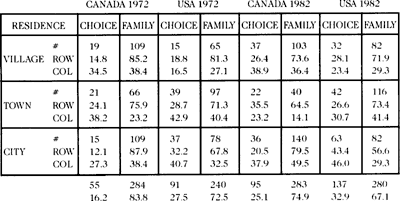
ETHNIC SOLIDARITY AMONG MENNONITE BRETHREN
Family socialization has been utilized as the central indicator of ethnicity in this study in order to permit examination of relationships between this and other family-related indicators of ethnic solidarity. Table IV indicates that among members who are socialized in homes in which both parents were M.B., more Canadian than U.S. members had never belonged to another denomination. The table also indicates that the proportion of Family members who have belonged only to the Mennonite Brethren church remains high but declined with urbanization. The changes during the decade are small in Canada but are more substantial in the U.S. The proportion of Choice members who have belonged only to the M.B. church declines between 1972 and 1982 while the proportion is smaller and remains constant in the U.S. Twenty-two percent of the Japanese respondents report previous membership in another Christian denomination, a personal religious history remarkably different from that reported by North American Choice members.
The data also indicate that within this sample of Family M.B.s who have never belonged to another denomination, approximately 60 percent in each country and decade married spouses who were also members of the M.B. church at the time of the wedding. In villages and towns in both countries the proportion of denominationally endogamous marriages {35} declined during the decade while in cities (contrary to what might be expected according to the model proposed in this study) the proportions increased. Few Japanese members report that their parents were members of Mennonite churches or even of other Christian denominations. Only 7.4 percent report that their fathers were Mennonite and 10 percent report that their mothers were Mennonite. An additional 3.4 percent of fathers and 5.6 percent of mothers were members of another Christian denomination.
The proportion of Family members who could report that none or one member of the immediate family belonged to another denomination shows a consistent pattern of decline during the decade (with the exception of Canadian town members). Comparable data for Japanese members are not available.
Table II
Ethnic Solidarity by Ethnicity, Country and Decade (Percent)
Family Memebers Only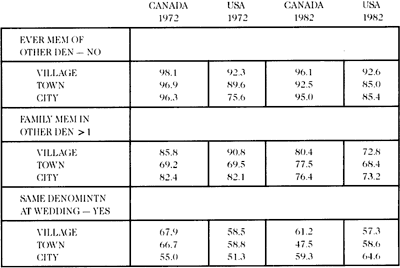
Table II reveals a general but not consistent pattern of change during the decade toward decreasing familial ethnoreligious solidarity among persons who were socialized in M.B. homes. In Canada (but not the U.S.) family members became less likely to have been members of the M.B. church {36} only. In both countries members of the immediate family are more likely to belong to another denomination. Rates of religious endogamy have generally declined. And most (but not all) of these patterns of change tend to become stronger with urban residence.
ETHNICITY AND ANABAPTISM
For purposes of this report, we have developed a series of indexes to test for differences in the patterns of theological commitments which characterize Choice, Family, and Japanese Mennonite Brethren. Do Mennonite Brethren with these three types of backgrounds differ in their theological orientations? Do these patterns of difference vary by country and decade?
Table III
Anabaptism By Ethnicity, Country and Decade (Means)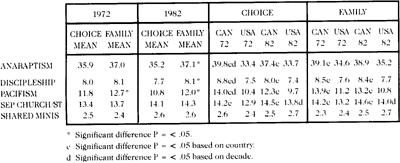
In this study, we have isolated four elements which we considered to be central to the Anabaptist theological tradition, were statistically correlated with each other, and provided a basis for testing for associations with other forms of religious expression. Our “Anabaptism Index” is a composite of four sub-indexes which measure these four elements of the Anabaptist theological tradition: Discipleship (three items), Pacifism (six items), Separation of Church and State (six items), and Shared Ministry (two items). Each item correlates (a statistical procedure for measuring relatedness between scores) significantly with each other item within the sub-index and within the composite Anabaptism index. Each sub-index correlates with each other sub-index and with the composite {37} index of Anabaptism. Japanese responses are not reported here because of the large number of index items which were missing from the Japanese version of the questionnaire.
Table III summarizes the scores of Choice and Family members by country and decade on the Anabaptism Index and the four sub-indexes of which it consists. The Table indicates that the mean scores of Family members are higher than the mean scores of Choice members on the composite Index of Anabaptism. (The * indicates when the difference in the averages of the index were significant on the basis of statistical analysis.) This general pattern also characterizes the U.S. membership in each decade and the Canadian membership in 1982. The exception to this pattern is the high scores reported by Canadian Choice members in 1972. Their mean score (39.8) on the Anabaptism Index is, in fact, the highest reported by any group listed in this Table. The mean score for U.S. Choice members in 1972 was, conversely, the lowest (33.4) of any group identified in the Table.
Mean scores on the Anabaptism Index are higher for Canadian members than U.S. members for each category and decade. Mean scores on the composite index of Anabaptism decline during the decade for Canadian members (both Choice and Family) and increase for U.S. members; thereby reducing the disparities in scores which existed at the beginning of the decade.
DISCIPLESHIP. Mean scores on the Discipleship subindex generally follow the pattern of the composite Anabaptism Index. Canadian members score higher than U.S. members, and 1972 scores are higher than 1982 scores (except for U.S. Family members in 1982). Family member scores are generally higher than the scores of Choice members except for Canadian Choice members in 1972 who, again, score higher than any other group.
The distributions of Choice and Family responses to several items from each of the four Anabaptism sub-indexes are reported in Table VI. The items were selected for presentation here either because (a) they represent the clearest and strongest differentiation in each sub-index between Choice and Family members (highest level of statistical significance) or because (b) their inclusion enables comparisons with Japanese Mennonite Brethren responses. Table IV summarizes the proportion of Choice and Family members who respond {38} positively to each item in each decade. The Table does not indicate differences between Canadian and U.S. member responses. In the following paragraphs, several patterns of differences and similarities are briefly identified. Comments concerning some of these items include references to distinctions between Canadian and United States members which are not presented in the Table.
Table IV
Items From the Discipleship Index
- If Christian believers proclaim the Lordship of Christ and truly follow Him in all of life they can expect to incur severe criticism and frequent persecution from the larger society. (strongly agree/agree)
- The Mennonite Brethren Church should practice a thorough church discipline so that faltering or unfaithful members can be built up and restored, or in exceptional cases, excluded. (strongly agree/agree)
- Jesus expects Christians today to follow the pattern which he set in his own life and ministry, including such things as putting evangelism above earning a living, and deeds of mercy above family security. (strongly agree/agree)
For example, the statement (147) “Jesus expects Christians today to follow the pattern which he set in his own life and ministry, including such things as putting evangelism above earning a living, and deeds of mercy above family security” represents the Discipleship sub-index. The highest proportion of persons in the North American sample who Agree or Strongly Agree with this statement was found among Canadian Family members in 1972 (58.2 percent) and the lowest proportion (34.5 percent) was among U.S. Choice members in 1972. Family members consistently score higher than Choice members, Canadian scores are consistently higher than U.S scores, and 1972 scores are higher than 1982 scores (except for {39} Canadian Choice scores which declined during the decade). The responses of Japanese members indicate a substantially higher rate of agreement (71.8%) with this item than any North American sub-group.
Family members are, similarly, more likely than Choice members to Agree or Strongly Agree that the Mennonite Brethren church should (144) “practice a thorough church discipline” though differences were not great enough to be statistically significant nor was change across the decade significant. Japanese members are less likely to be in agreement with this statement.
A different pattern appears in responses to the question concerning persecution of believers. The Japanese are most likely to agree with this statement, followed by Choice members in 1972. During the decade, Choice members became less likely to agree with this statement while Family members became more likely to agree, though these differences were not statistically significant.
While differences between Choice and Family members in responses to the Discipleship sub-index were not significant in 1972, these differences had become significant by 1982. Significance is due in large part to declining scores on the part of Choice members while Family members’ scores remained essentially unchanged.
Table V
Items From the Pacifism Index
- The Christian should take no part in war or any war-promoting activities. (strongly agree/agree)
- Mennonite Brethren should actively promote the peace position and attempt to win as many supporters to the position as possible from the larger society. (agree)
- A member of our churches ought not to pay the proportion of his income taxes that goes for military purposes. (disagree) {40}
- Which one of the following positions would you take if faced with a military draft? a) regular military service b) non-combatant military service c) alternative service (I-W, VS, or Canadian alternative service) d) register, but refuse induction or service e) refuse to register.
- Capital punishment (the death penalty for a major crime) is a necessary deterrent to crime and should not be abandoned by our national, provincial, or state governments. (agree)
Table VI
Responses To the Military Draft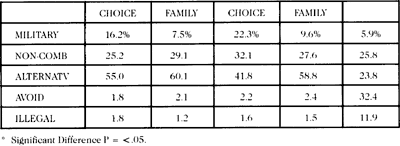
PACIFISM. Means on the Pacifism sub-index follow the same pattern as the Anabaptism index and the Discipleship sub-index. Respondents who Agree or Strongly Agree with the statement (139) “The Christian should take no part in war or any war-promoting activities.” reveal this pattern (Table V). Family members are more likely to agree than Choice members. Canadian M.B.s are consistently more likely than U.S. M.B.s to agree with this statement of the Pacifist position. Respondents were more likely to respond positively in 1982 than in 1972 except among Choice members in the U.S., who declined in their rate of positive responses to this item. Japanese members, again, indicate near unanimous (94 percent) support for this statement in contrast to North American responses which are in the 50 percent range. Table VI indicates how various types of Mennonite Brethren respond to a question concerning a military draft.
CHURCH-STATE SEPARATION. Scores on the Separation of Church and State index (TABLE VII) reveal similar patterns, though with less consistency. Family members score higher {41} than Choice members except for identical scores among Canadian members in 1972. Canadian scores are, again, higher than U.S. scores. But the direction of change during the decade is the reverse of the patterns noted to this point. Scores for 1982 are higher than 1972 scores except for Canadian Choice members.
Family members are more likely than Choice members to Agree or Strongly Agree with the statement (145) “It is against the will of God for a Christian to swear the oath demanded by the civil government on occasions.” Canadian respondents are consistently more likely to agree with this statement from the Separation of Church and State index than U.S. members. Respondents were consistently more likely to strongly agree with this statement in 1972 than in 1982. This item was not included in the Japanese questionnaire because of differences in culture.
Table VII
Items From the Church State Index
- It is against the will of God for a Christian to swear the oath demanded by the civil government on occasions. (strongly agree/agree)
- Christians ought not participate in peaceful demonstrations and protest marches even though they may be intended as a means of bringing about social justice. (agree)
SHARED MINISTRY. Scores on the Shared Ministry index reveal no consistent pattern. The mean score for Choice members is higher than the mean score for Family members because of the higher scores of Canadian Choice members in 1972. Other national comparisons show identical scores for Choice and Family members. Scores for 1982 are higher than 1972 in three of four comparisons. U.S. scores are higher than Canadian scores in three of four comparisons. Because the Shared Ministry index contains only two items, differences tend to be small and, because of the inconsistencies in the {42} patterns, the sub-index contributes little to the patterns which are noted for the Anabaptist index as a whole.
The proportion of respondents who Agree or Strongly Agree with the statement (149), “A church congregation cannot be complete unless there is an ordained minister to lead the congregation and perform the ministerial functions,” is consistently greater among Choice than Family members. U.S. scores were higher in 1972 but Choice members (61.1) were significantly more likely to agree than Family (50.8*) in 1972. The scores in 1982 were Choice (49.2) and Family (47.3). Canadian scores were higher than U.S. scores in 1982 on this item from the Shared Ministry index. Japanese members indicate little support for this indicator of a “Shared Ministry” understanding of the church with virtually all (97.8) agreeing that an ordained minister is essential to the life of a congregation.
Several additional items which indicate Anabaptist-Mennonite interests and commitments were not included in any index. Most members agreed that “Baptism is neither necessary nor proper for infants and small children” (Question 138). Family members agreement was 85.2 in 1972 and 86.4 in 1982; Choice members agreement was 88.4 in 1972 and 84.5 in 1982. Japanese members are less likely than North Americans to agree (80.6). Japanese members were asked to indicate their opinions concerning retention of the name “Mennonite” in their church or denomination. Only 2.8 percent indicated that the name is an obstacle, 50.8 percent advocate retention of the name, and 46.4 percent indicate that they have no interest or opinion concerning the name “Mennonite.” Given the opportunity to select an identifying characteristic from a list of four options, 49.7 percent of the Japanese members correctly identified Menno Simons as an early leader of the Anabaptist movement, 41.1 percent associated Michael Sattler with the Schleitheim Confession, and 58.6 percent recognized Ulrich Zwingli as the leader of church reform in Zurich.
Scores on individual items from the sub-indexes, then, reveal in greater detail the general patterns shown in total responses to the composite Anabaptism index. North American Family members tend to indicate more support than Choice members for some of the basic ideals of the Anabaptist tradition. Canadian members support these ideals more strongly than U.S. members. Attachment to these ideals have {43} generally weakened during the decade among all sub-groups except U.S. Family members. Japanese members score very high on items related to pacifism but they do not support political action to express these commitments. The Japanese members do not indicate support for a shared ministry. They generally reject the appropriateness of infant baptism. They are somewhat informed about Anabaptist-Mennonite history. Very few Japanese members view the name “Mennonite” as problematic.
PRIVATISM AND ETHNICITY
What patterns of Christian faith increase with the decline of attachments to Anabaptist-Mennonite particularities? What new spirits move into the house of Menno as the older “ghosts” of ethnic and sectarian peculiarity are exorcised? The model upon which this study is based predicts that a compatible form of religiosity from the dominant culture will be adopted as upward socio-economic mobility and cultural assimilation progress. What evidence is there that new patterns of mainstream religiosity increase with the decline of the ethno-religious tradition?
Many observers have noted that religious faith becomes increasingly personal, subjective, and private as the corporate, institutional forms of traditional religions decline with “modernization.” The individualistic “voluntarism” of the evangelical Anabaptist tradition is, of course, compatible with a personal, subjective religious faith and has, in fact, contributed to the emergence of the privatized religiosity which characterizes “modernity.” Do the data indicate that within the M.B. conferences movement away from the Anabaptist-Mennonite heritage is accompanied by an increase in “Privatism?” Do Anabaptism and pietism change together or do they move in opposite directions?
The Privatism Index is a composite of eight sub-indexes: Direction, Relationship to God, Personal Bible Study, Prayer, Personal Evangelism, Charismatic Experience, Positive Religious Emotion, and Negative Religious Emotion. Each subindex consists of several items which indicate specific aspects of a personal, individualistic form of Christian faith. Indexes vary from three items (Direction, Personal Evangelism, Charismatic Experience) to five items (Relationship to God). These {44} data are reported on Tables VIII and IX.
Mean scores on the Privatism Index indicate that Choice members score higher than Family members, Canadians score higher than U.S. members (except for Choice members in 1982), and that 1972 scores are higher than 1982 scores for Canadian members while 1982 scores are higher than 1972 scores for U.S. members. The highest scores are reported by Canadian Choice members in 1972, the lowest scores are reported by U.S. Family members in 1972.
Table VIII
Privatism by Ethnicity, Country and Decade (Means)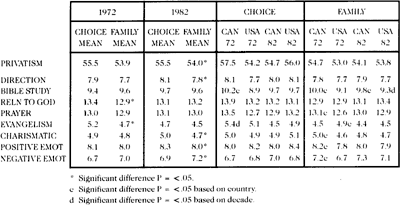
Table IX
Items From the Privatism Sub-Indexes
DIRECTION
- In regard to the quality of your spiritual life, which of the following best describes your progress during the past couple of years? (I am making definite progress/little progress) {45}
BIBLE STUDY
- How often do you study the Bible privately, seeking to understand it and letting it speak to you? (frequently/daily)
- How often do you experience a family, private, or cell group devotional period in which the Bible or other religious literature is read? (daily/more than once a day)

RELATIONSHIP TO GOD
- In general, how close do you describe your present relationship to God? (close/very close)
PRAYER
- Other than at mealtime, how often do you pray to God privately on the average? (several times per day/daily)
- When you are tempted to do something wrong, how often do you ask God for strength to do the right? (very often/often)

EVANGELISM
- How frequently do you take the opportunity to witness orally about the Christian faith to persons at work, in the neighborhood, or elsewhere? (very often/often)
- How frequently have you invited non-Christians to attend your church and/or Sunday school services? (frequently/occasionally)
- To your knowledge, have you ever been instrumental in someone’s conversion? (yes, often/yes, a few times) {46}

CHARISMATIC
- An experience of speaking in tongues (Definitely not)
POSITIVE EMOTION
- A sense of being loved by Christ (Yes I’m sure I have)
NEGATIVE EMOTION
- How often do you feel discouraged in your efforts to live a Christian life? (very often/often)
The pattern of Choice members scoring higher than Family members is true for each sub-index except for identical scores on the Personal Bible Study Index. Family members also score higher on the Negative Emotion index which actually reflects the expected pattern of a more positive personal religiosity among Choice members than Family members. In 1972 Canadians scored higher than U.S. members in 14 of 16 comparisons. In 1982 Canadian and U.S. members’ mean scores on the sub-indexes were approximately even. U.S. members’ scores generally increased during the decade while Canadian scores generally declined.
The direction of change, then, indicates a weak but fairly consistent pattern which is the inverse of what we have seen for the Anabaptism Index: Choice members and 1982 scores are generally higher than Family members and scores in 1972. If this pattern continues, the M.B. conferences will be increasingly characterized by a warm personal faith which does not express itself in a radically disciplined community of Christian peace.
A review of items from the Privatism index indicates that Choice members are more likely than Family members to be engaged in personal evangelism and they generally indicate higher levels of emotionality in their Christian faith. Japanese members are faithful in their practice of personal prayer and Bible study but less likely to be involved in group Bible study. {47} They are as active as North Americans in personal witnessing but less likely to have been instrumental in someone’s conversion.
CONGREGATIONALISM AND ETHNICITY
Robert Bellah and others, as already noted, have suggested that the meaning of the religious group gathered for fellowship and worship changes with the development of a culture which is centered, in part, on “expressive individualism.” The nature of the congregation shifts from being a part of a larger “community of memory” which is grounded in a religious authority external to the self to a “life-style enclave.” The “life-style enclave” is based, primarily, on the expressive needs of the individual member, is concerned with only selected segments of the total being of the member (particularly personal emotional needs and support for nuclear family relationships), and is composed of a narrowly bounded set of persons who share a limited range of common interests (including, perhaps, celebration of “symbolic ethnicity”). Bellah alerts us to the fact that the essential meaning of congregational life might be transformed, even while the external forms continue unchanged.
With this possibility in mind, we have compared the patterns of involvement in congregational life which characterize Choice and Family members in Table X. We might expect that in communities which include Choice and Family members, the latter will feel more accepted and be more involved in the life of the congregation. To our surprise we found exactly the opposite. Choice members are more likely to be involved in the life of the congregation than Family members. This general pattern of differences reached the level of statistical significance in 1982. The pattern consistently characterizes differences between Choice and Family members in both countries and decades except for Canada in 1982. Scores on the Congregational Involvement index increased significantly for U.S. members during the decade.
A review of the sub-indexes (Table XI) indicates that U.S. members scored higher than Canadian members in both Service Experience and Service Attitudes. Stewardship Performance improved during the decade. Canadian members experience higher degrees of identification with the {48} congregation, though the scores of U.S. members increased significantly during the decade. The only significant difference in association with other members is the higher scores of U.S. Choice members in 1982.
Table X
Congregationalism by Ethnicity, Country and Decade (Means)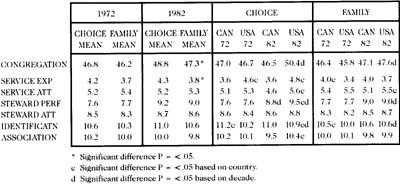
Table XI
Items From the Congregationalism Sub-Indexes
SERVICE EXPERIENCE
- Do you presently hold, or have you held within the past three years, a position of leadership in your local congregation (minister, elder, council member, officer, S.S. teacher, committee chairman, youth group officer or sponsor, etc.) (Yes)
SERVICE ATTITUDE
- Do you think every young person in our churches should be encouraged to devote a couple of years to some type of voluntary service whether or not he or she is faced with a draft? (yes) {49}
STEWARDSHIP PERFORMANCE
- Which is closest to your pattern of giving money to church budget and offerings? (I give a planned amount)

STEWARDSHIP ATTITUDE
- In line with the world’s spiritual and physical needs and your resources, how frequently do you give in offerings the amount of money you feel you should give? (always/usually)
IDENTIFICATION
- How much spiritual inspiration and strengthening do you feel you get from a typical Sunday morning worship service in your congregation? (very much/quite a lot)
- How well do you feel you fit in with the group of people who make up your church congregation? (I fit in very well)
- Think for a moment about whom you would list as your five closest friends (outside your family). How many of these five friends are members of your local congregation? (Four/Five)
ASSOCIATION
- On the average, how often have you attended church worship services (on Sunday morning, evening, and/or other days) during the past two years? (once a week/more than once a week)
Item scores in Table XI indicate that Choice members are more likely to occupy positions of leadership in the church, to make financial offerings according to a specific plan (Japanese members virtually all give according to a planned schedule.), and experience more inspiration in worship services. Family members are more likely to have friends in the congregation. Japanese members attend worship services less regularly. {50}
From these data we cannot know, of course, whether the surprising degree of acceptance and participation expressed by Choice members indicates that they have been truly grafted into a living spiritual vine, that they are forced to “try harder” because they are merely second-class members, that the comparative scores actually reflect disengagement on the part of some Family members, or that the nature of congregational life has subtly shifted in meaning.
ETHICAL CONSERVATISM AND ETHNICITY
The ethnic group is defined, in part, by its cultural particularity. Ethical standards might be considered to be one dimension of a cultural system. Delbert Wiens has described how the ethics of the traditional community differ from the ethical work demanded in a pluralistic social environment (1987). We might expect, then, to find significant shifts in ethical positions with the transition from the relatively closed and homogeneous agrarian village to the pluralism of the urban social environment. We might expect to find that life-style standards move toward conformity with others who occupy similar positions in the urban social ecology.
Mennonite Brethren remain ethically conservative. The statistically significant difference between Choice and Family members in scores on the Ethical Conservatism index in 1982 primarily reflects the fact that more Family members have never danced or drunk alcoholic beverages (Table XII). Choice and Family members do not differ significantly on other sub-indexes (Table XIII). Canadian Family members are more conservative than U.S. members in matters related to family, sexual behavior, and abortion. The only significant changes during the decade were a decrease in Canadian Choice members’ scores on the Personal Ethics subscale and an increasingly conservative stance on abortion among U.S. Family members.
The responses to items which are reported on TABLE XIII indicate that Japanese members express less opposition to marriage between Christians and non-Christians, are less likely to view marriage as a lifelong commitment, are less strongly opposed to moderate consumption of alcohol, but are more likely to oppose attendance at movies. {51}
Table XII
Ethics and Ethnicity, Country and Decade (Means)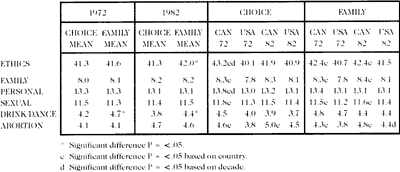
We find, then, few differences between Choice and Family members, indicating that Mennonite Brethren do not differ radically from other ethically conservative citizens. The differences which do appear (experience of drinking alcohol and dancing) reflect residuals from an older definition of the boundary between church and world which is of decreasing significance in the new social environment. Ethical peculiarity, then, is of decreasing significance as an identifying mark of the Mennonite Brethren.
Table XIII
Items From the Ethics Sub-Index
FAMILY
- Marriage of a Christian to a non-Christian (always wrong).
- Which statement best expresses your view of marriage? (a lifelong commitment). {52}
PERSONAL
- Drinking alcoholic beverages (moderately) (always wrong).
- Smoking tobacco (always wrong).
- Attending movies rated for adults and children (always wrong).


SEXUAL
- Extra-marital sexual intercourse (always wrong).
DRINKING AND DANCING
- Which of the following describes the extent to which you have drunk alcoholic beverages in your lifetime? (never drank any)
- To what extent have you participated in social dancing? (never)
RACE RELATIONSHIP
- Although there is no essential difference between blacks and whites, it is preferable for them not to mingle socially. (disagree)
POLITICAL INVOLVEMENT AND ETHNICITY
Our theoretical framework predicted that Family members would be less involved in political activity. Index scores indicate that in 1972 Choice members were more likely than Family members to be politically involved but the reverse was true in 1982 (TABLE XIV). The political involvement of U.S. members is higher than that of Canadian members. The political involvement of U.S. Family members also increased significantly during the decade, resulting in a widening gap between U.S. and Canadian members. The two items from the Political Involvement index generally reflect these patterns. They also indicate that most members vote regularly in elections but they do not feel that ministers should express political {53} concerns from the pulpit. Japanese members respond similarly (TABLE XV).
Table XIV
Politics and Fundamentalism by Ethnicity, Country and Decade (Means)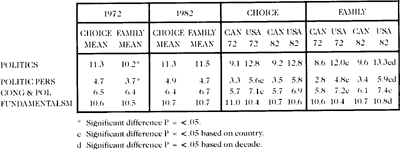
Table XV
Items From the Political Involvement and Fundamentalism Sub-Indexes
PERSONAL POLITICAL INVOLVEMENT
- In how many of the elections in recent years have you voted? (all/most)
CONGREGATIONAL POLITICAL INVOLVEMENT
- g. Do you feel it is proper for your congregation to encourage the minister to discuss political issues from the pulpit? (Yes)
FUNDAMENTALISM
- Jesus will actually return to earth some day. (definitely)
- God created the earth and all living things in six 24-hour days. (definitely) {54}
- All persons who die not having accepted Christ as their redeemer and savior will spend eternity in a place of punishment and misery. (definitely)
FUNDAMENTALISM AND ETHNICITY
Mennonite Brethren remain highly committed to a set of statements which reflects a conservative evangelical or fundamentalist theology. The only statistically significant difference in scores on this index was an increase in scores among U.S. Family members during the decade. TABLE XV indicates virtually unanimous agreement that Jesus will “actually” return to earth some day, though Japanese members express slightly less agreement with this statement. Slightly more than one half of the members in each category agree that creation “definitely” took place in six 24-hour days. Family members are more likely than Choice members to agree that the unsaved will “definitely” “spend eternity in a place of punishment.” Though approximately 85 percent of North American members “definitely” agree with this statement, only 54.5 percent of Japanese members are able to do so.
CONCLUDING SUMMARY: ETHNICITY BY COUNTRY
We began this report with some questions about the implications for the future which might be indicated in the patterns of similarities and differences between “ethnic” and “nonethnic” members in Canada and the U.S. and the changes which these groups reflect during the decade 1972-1982. The problems related to a definition of Mennonite Brethren identity are complicated not only by diversity and change within the North American membership, but also by the expansion of our boundaries beyond the confines of the western European historical traditions to include, among others, Japanese fellow members. Some of the social, demographic, cultural, and religious differences between selected sub-groups have been reflected in the analyses of Anabaptism and other indexes which have been suggested thus far. Some generalizations, not about the indexes but about the sub-groups of members, will begin these concluding comments. {55}
Canadian Mennonite Brethren
- Canadian members generally indicate higher levels of commitment to the Anabaptist heritage, are more pious, more heavily engaged in congregational life, more ethically conservative, less involved politically, and more fundamentalistic than U.S. members. But the magnitude of these differences between the two countries declined during the decade.
- Canadian Choice members scored very high on most dimensions of religiosity in 1972. They were stronger than any other category of members on the Anabaptism, Privatism, and Ethical Conservatism indexes and they ranked second in scores on the Fundamentalism index. Canadian Choice members’ scores and relative rankings on each of these indexes declined during the decade.
- Canadian Family members also scored high in 1972 on the Anabaptism, Privatism, and Ethical Conservatism indexes. They scored low on the Congregationalism, Political Involvement, and Fundamentalism indexes. During the decade, their scores and relative rankings declined slightly or remained approximately the same on the Anabaptism, Privatism, and Ethical Conservatism indexes. Scores on Congregationalism, Fundamentalism, and Political Involvement increased.
- Canadian Choice and Family members’ scores were more alike in 1982 than they had been in 1972.
U. S. Mennonite Brethren
- U.S. members generally scored lower than Canadian members on the Anabaptism, Privatism, Congregationalism, Ethical Conservatism, and Fundamentalism indexes. They consistently scored higher than Canadian members on the Political Involvement index.
- The magnitude of these differences between the two countries declined during the decade as Canadian scores generally decreased while U.S. members’ scores increased.
- U.S. Choice members scored lower than any other group on the Anabaptism and Ethical Conservatism indexes and high on the Political Involvement index in both decades. Their scores on the Privatism, Congregationalism, Political Participation, and Fundamentalism indexes ranked high at the end of the decade.
- U.S. Family members also scored low on Anabaptism {56} and Privatism in both decades. During the decade their scores and relative rankings rose on the Anabaptism, Congregationalism, Ethical Conservatism, Political Involvement, and Fundamentalism indexes.
- The scores of U.S. Family members in 1982 were generally quite close to the mean score for Choice and Family members, between countries, and across the decade except for the unusually high score of U.S. members on the Political Involvement index. The profile of U.S. Family members appears to approximate the profile towards which groups move as differences between Choice and Family, Canadian and U.S. members diminish.
Japanese Mennonite Brethren
Japanese Mennonite Brethren reflect acceptance of the Anabaptist heritage in that they are committed to following the example of Jesus in personal discipleship, score high on items related to the peace position, and expect that faithful Christians will experience persecution. They do not support an understanding of the church as a disciplined community, however, nor do they accept a vision of shared ministry in the church. They are faithful in private Bible study and prayer, in personal witnessing, and they are committed to patterned financial giving. They sense personal acceptance in their congregations even though they do not share many close friendships within the group and are frequently absent from worship services and other gatherings. They are conservative in their ethics and do not support demonstrations and political involvements as appropriate expressions of Christian faith. Their theology is also conservative, though they are not able to agree with statements of the fundamentalist position with the strength of North American members.
IMPLICATIONS
Theoretical Model
Some, but not all, of these data support the assimilation model of interpreting relationships between groups in contemporary society. North American Mennonite Brethren follow a typical pattern of change in experiencing upward socio-economic mobility and a transition from rural to urban {57} life. As we do so, we become more pluralistic in our membership and less distinctive from the dominant culture in our social, religious, and cultural patterns of thought and behavior.
These general patterns appear to be similar in Canada and the United States, in spite of differences in national policy. Canadian “pluralism” does not produce the patterns of increasing ethno-religious particularity that one might expect. Neither has the “great melting pot” model which has dominated strategies of ethnic group relations in the United States accelerated the rate of assimilation as we might have expected. Convergence in Canadian and U.S. members’ scores indicates, in fact, that change is moving in opposite directions from the respective national policies.
Exceptions demonstrate that these patterns are neither inevitable nor irreversible. Nor are they entirely undesirable. But the data do call us to honest and forthright discernment of the times in which we live if we are to experience Christian freedom from the “principalities and powers” of this present age in order to become, again, a new creation in Christ.
Mission
The Japanese Mennonite Brethren experience of selective acceptance of the Christian faith indicates, in part, the power of culture to shape both the sending and the reception of the Gospel message. The responses of the Japanese Mennonite Brethren indicate that in receiving that message they utilized priorities which differ from those that might have been intended by the sending agencies. It is remarkable to note that a higher proportion of the Japanese membership agrees that “The Christian should take no part in war” (94 percent) than the North American membership (approximately 50 percent). The proportions are reversed in “definitely” agree responses to the statement that “All persons who die not having accepted Christ as their redeemer and savior will spend eternity in a place of punishment and misery” (Japanese, 54.5 percent, North American responses approximately 85 percent).
Cultures shape the manner in which elements of Christian faith are interpreted and prioritized. Dialogue within the community of faith between fellow members of dramatically different cultural backgrounds can contribute to our clearer understandings of the meaning of the Kingdom of God among us. The creation of mechanisms for that dialogue should be {58} understood as an essential component of the total mission enterprise.
Conference Identity
It is remarkable, indeed, to note that Canadian attachments to Anabaptist distinctives appear to have been at a higher level than the Anabaptist-Mennonite convictions of U.S. members at the beginning of the decade but declined during the ten year period while U.S. members’ scores increased. Perhaps this tendency towards convergence indicates that the “fork in the road” which was perceived by John E. Toews (64) does not present us with a choice between North and South so much as a choice between alternative Christian subcommunities within the context of North American cultural pluralism and the faith stories which these varied subcommunities have inherited. The story of our immediate past is one of holding in tension a fragile combination of a Mennonite story of withdrawal from participation in the dominant institutions of the societies around us and an evangelical story which tends to be much more affirming of the dominant culture. As that dominant society becomes more open to religious and cultural pluralism (including a growing acceptance of both the religious and cultural heritage of the descendants of Menno) and as the children of Menno also discover ways of being faithful to their tradition without the rigidity of their persecuted, migrant, minority past, perhaps we have the opportunity to create new forms which are more appropriate to the present situation than the limited options of either ethnic conservatism or evangelical accommodation.
BIBLIOGRAPHY
- Bellah, Robert. Habits of the Heart: Individualism and Commitment in American Life. New York: Harper and Row, 1985.
- Hamm, Peter M. Continuity and Change Among Canadian Mennonite Brethren. Waterloo, Ontario: Wilfrid Laurier University Press, 1987.
- Kauffman, J. Howard, and Harder, Leland. Anabaptists Four Centuries Later. A Profile of Five Mennonite and Brethren in Christ Denominations. Scottdale, Pa.: Herald Press, 1975.
- Redekop, John. A People Apart: Ethnicity and the Mennonite Brethren. Winnipeg: Kindred Press, 1987.
- Toews, John E. “Theological Reflections.” Direction 14 (Fall, 1985): 60-68. {59}
- Toews, Paul. Mennonites in America 1930-1970: Modernity and the Persistence of Religious Community. Mennonite Experience in America Project. In Process.
- Warner, Miriam. “Mennonite Brethren: The Maintenance of Continuity in a Religious Ethnic Group.” PhD dissertation, Department of Anthropology, University of California, Berkeley, 1985.
- Wiens, Delbert. “The Moralities of the Mennonite Brethren,” a paper read at the Mennonite Brethren Bible College in Winnipeg, November 15, 1986. An edited version appeared in Direction, 16 (Fall, 1987): 29-44.

